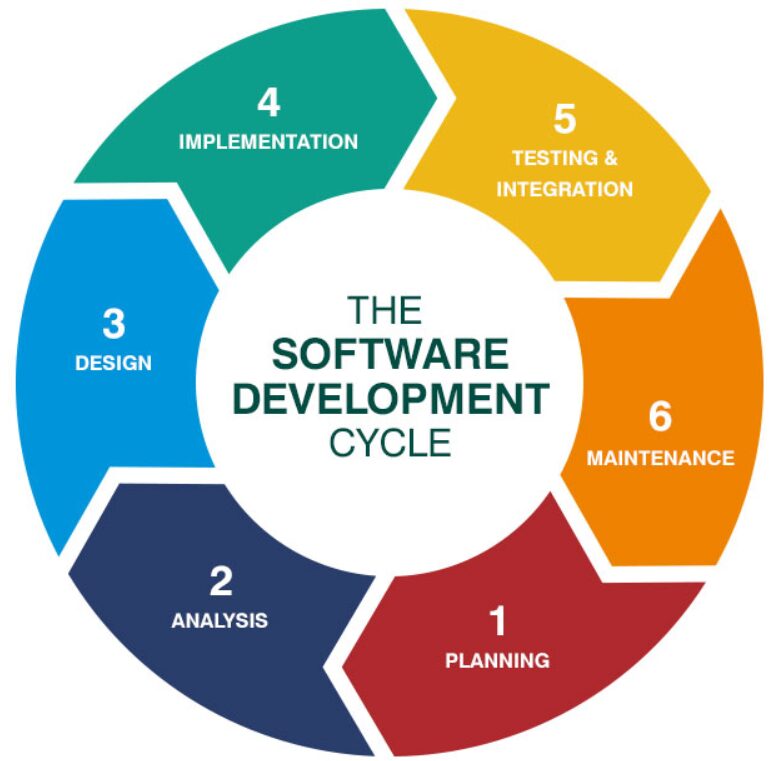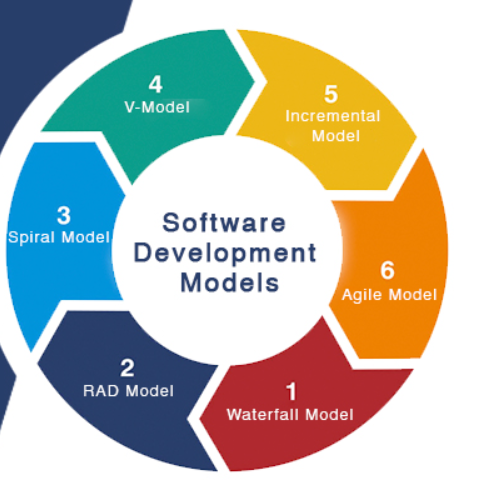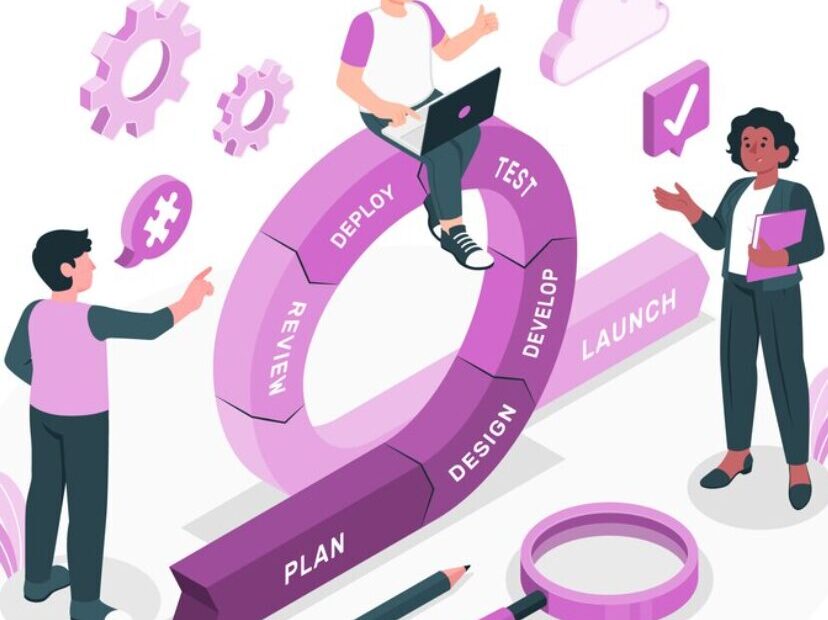The Software Development Life Cycle (SDLC): Is the term used by software developers and IT teams to create a new software product, design, develop, and test high-quality software efficiently. The goal of the Software development life cycle is to produce software that meets or exceeds customer expectations, reaches completion within times and cost estimates, and is efficient and error-free.
The methodology for developers: they design and write modern software for computers, cloud deployment, mobile phones, video games, and more.
and SDLC methodology helps to optimize the final outcome.
The Importance of SDLC
- Ensures a Systematic Approach: The Software development life cycle provides a systematic approach to software development,
which helps in managing the complexity of developing software. By breaking down the development process into distinct phases, teams can focus on specific tasks at each stage,
which helps in managing workloads and ensuring that each aspect of the software is given due attention. - Improves Quality: Quality is a paramount concern in software development, and the Software development life cycle plays a critical role in ensuring that software products meet quality standards. Through various stages, the SDLC allows multiple quality checks and balances. This process helps in identifying and fixing bugs early, leading to a more stable and reliable software product.
- Project Management: The Software development life cycle provides a clear framework for project management, including timelines, deliverables, and milestones. This clarity helps in planning, scheduling, and resource allocation, making it easier for project managers to track progress, manage teams, and ensure that projects are delivered on time and within budget.
- Communication: Effective communication among stakeholders is essential for the success of any software project. The Software development life cycle promotes transparency and facilitates communication by providing clear documentation of processes, requirements, and progress at each stage of development. This helps in aligning the expectations of stakeholders, including developers, project managers, clients, and users.
- Reduces Risks: By incorporating stages such as thorough requirements analysis and extensive testing, the SDLC helps in identifying potential risks early in the development process. This early detection allows teams to take corrective measures sooner, reducing the chances of project failure, cost overruns, and delays.
- Adapts to Change: Modern SDLC models, such as Agile, are designed to be flexible and responsive to change. This adaptability is crucial in today’s fast-paced technological landscape, where requirements can change rapidly due to market trends, user feedback, or new technological advancements.
Stages Of SDLC
Stages of SDLC, each with its own set of activities and goals, designed to ensure the efficient and effective production of software that meets or exceeds customer expectations.
- Planning: This initial stage involves defining the scope of the project, including its objectives, constraints, and assumptions. Stakeholders identify the resources required, prepare a budget, and create a detailed plan outlining the project’s timeline and milestones.
- Requirements Analysis: In this stage, the project manager & team gathers and analyzes requirements from the stakeholders to understand what the software should do and how it should perform.
This stage is critical for laying down a solid foundation for the software project. Functional, non-functional, and system requirements are documented and reviewed for approval. - Design: Based on the requirements analysis, the design stage focuses on defining the software architecture, components, interfaces, and data models. This stage involves making decisions about the coding language,
platforms, and hardware where the software will run. Design documents and diagrams are created to guide developers and ensure compliance with the project goals. - Implementation (or Coding): In this stage, developers begin the actual coding based on the design documents. The goal is to implement all features, functions, and processes outlined in the design. This stage requires a disciplined approach to coding, adherence to coding standards,
and regular code reviews to ensure quality and progress. - Testing: Once the software is developed, it undergoes thorough testing to identify and fix bugs or defects. This stage includes various types of testing,
such as unit testing, integration testing, system testing, and user acceptance testing, to ensure the software meets all requirements and functions correctly in all scenarios. - Deployment: After testing, the software is deployed to a production environment where end users can access it.
This stage may involve rolling out the software in stages or all at once, depending on the deployment strategy. The deployment stage also includes training end users and preparing operational environments. - Maintenance and Support: Even after deployment, software requires ongoing maintenance and support to address any issues, implement updates,
and ensure it continues to meet user needs over time. This stage involves bug fixes, performance enhancements, and the addition of new features based on user feedback.
In the end Retirement happens, when the software becomes outdated or is no longer needed,
it enters the retirement stage. This involves planning for the migration of data and resources, decommissioning the software, and ensuring that stakeholders are transitioned to new systems if necessary.

Software Development Models
Different models offer various approaches to software development, catering to the specific needs, goals, and constraints of projects.
Waterfall Model
- Description: The Waterfall model is one of the earliest and most straightforward software development methodologies.
It is a linear and sequential approach where each phase must be completed before the next phase begins. - The main stages include requirements analysis, design, implementation, testing, deployment, and maintenance.
- Use Cases: Best suited for projects with well-defined requirements and where changes are unlikely to occur during the development process.
- Description: The Waterfall model is one of the earliest and most straightforward software development methodologies.
Agile Model
- Description: The Agile model is a highly flexible and iterative approach to software development. Unlike the Waterfall model, it allows for continuous feedback and changes throughout the development process.
- Development is carried out in short cycles or sprints, leading to incremental builds to ensure the product meets user needs.
- Use Cases: Ideal for projects requiring flexibility and where requirements are expected to change or evolve.
V-Model (Validation and Verification Model)
- Description: The V-Model is an extension of the Waterfall model that emphasizes the importance of testing at each stage of development.
- Each development phase has a corresponding testing phase, ensuring thorough validation and verification of the product at every step.
- Use Cases: Suitable for projects where quality assurance is a priority, and there is a clear understanding of the requirements.
Incremental Model
- Description: This model involves breaking down the project into small, manageable increments or modules.
- Each increment is developed through a series of phases (requirements, design, implementation, and testing) and is fully integrated into the existing system before moving on to the next.
- Use Cases: Works well for projects that need to demonstrate progress in stages or where requirements are known but expected to evolve.
Spiral Model
- Description: The Spiral model combines elements of both iterative and waterfall methodologies. It focuses on early identification and reduction of project risks by dividing the project into smaller components.
- Each cycle in the spiral includes planning, risk analysis, engineering, and evaluation.
- Use Cases: Best for large, complex projects with significant risks, where requirements are not well-understood or are expected to change.
DevOps
- Description: DevOps is more of a culture or practice than a model, aimed at unifying software development (Dev) and software operation (Ops). It emphasizes automation, continuous integration, continuous delivery, and quick feedback loops to improve the quality and speed of software delivery.
- Use Cases: Ideal for projects aiming for rapid delivery and where collaboration between development and operations teams is crucial.
Scrum
- Description: Scrum is an Agile framework that focuses on managing tasks within a team-based development environment.
- It is characterized by fixed-length iterations called sprints (usually 2-4 weeks), with a set of features to be delivered at the end of each sprint.
- Use Cases: Suitable for projects with rapidly changing or highly emergent requirements, and where the aim is to deliver working software quickly.
Each software development model has its advantages and limitations, and the choice of model depends on the project requirements, team size, project complexity, and other factors.
Understanding these models helps organizations select the most appropriate approach for their software development projects, ensuring better outcomes and more efficient processes.

Software Developer Careers And Job
Career in software development offers a blend of creative problem-solving, technical expertise, and the opportunity to make a significant impact in various industries.
Roles and Specializations
Software developers can work in a variety of roles, depending on their interests and skills:
- Frontend Developer: Specializes in developing the user interface and user experience of a software application.
- Backend Developer: Focuses on server-side logic, database interactions, and integration of application components.
- Full-Stack Developer: Has the capability to work on both the frontend and backend parts of an application.
- DevOps Engineer: Works on automating the software deployment process and improving system reliability and performance.
- Software Architect: Designs the overall structure of the software system, ensuring it meets business requirements and is scalable.
Enozom
A Software development company based in Alexandria, Egypt,
known for its comprehensive range of services aimed at small and medium enterprises and also serving as an outsourcing destination for large software firms globally.
Their expertise includes web development, web design, mobile app development, and software testing.
leverage the latest technologies to deliver high-quality software products that meet customer requirements,
environmental factors, and constraints. Emphasizing partnership,
Enozom has developed long-term relationships with clients from the UK, USA, Germany, Egypt, and KSA.
The company follows agile methodologies not just in processes but also in way of thinking, planning, designing, and executing, ensuring that their products perform well according to customer needs.
Enozom is known for its focus on high standards of quality control and methodologies, ensuring that the software passes through various tests to meet quality goals and customer requirements.
Learn About Software Development
Learning software development from experts can significantly accelerate your understanding of both fundamental and advanced programming concepts. Experts learning can come in various forms, including online courses, workshops, webinars, mentoring, and books authored by industry veterans.
1.Online Courses.
- Platforms: Websites like Coursera, Udacity, edX, and Pluralsight offer courses taught by industry professionals and university professors.
- Benefits: They provide structured learning paths, from beginner to advanced levels, often with real-world project experience.
- Choosing Wisely: Look for courses with high ratings, updated content, and hands-on projects to ensure you’re learning current industry practices.
2. Coding Bootcamps
- Intensive Learning: Bootcamps like General Assembly, Hack Reactor, and Flatiron School offer immersive programs focusing on rapid skill acquisition.
- Outcome-Oriented: Many bootcamps have strong ties to the industry and offer career support, making them a practical choice if you’re looking to enter the workforce quickly.
3. Technical Workshops and Webinars
- Interactive Learning: Workshops and webinars provide opportunities to interact with experts in real-time, allowing for immediate feedback and clarification of doubts.
- Networking: These events often offer networking opportunities, which can be valuable for career development and mentorship.
4. Mentorship Programs
- Personalized Guidance: Having a mentor in the software development industry can provide personalized advice, guidance on career development, and insights into industry trends.
- Finding a Mentor: Look for mentorship opportunities through LinkedIn, industry meetups, or organizations like Coding Coach and MentorCruise.
5. Contribute to Open Source Projects
- Real-World Experience: Contributing to open source projects allows you to work alongside experienced developers, gaining insights into coding standards and collaboration in a real-world setting.
- GitHub: Platforms like GitHub are great places to start. Look for projects that welcome beginners and offer good documentation on how to contribute.
6. Read Books and Articles
- In-Depth Knowledge: Books by experts can provide deep insights into programming languages, software architecture, design patterns, and more.
- Stay Updated: Follow blogs, newsletters, and publications from reputable sources to stay informed about the latest trends and best practices.
7. Join Developer Communities
- Participation: Engage actively by asking questions, sharing your knowledge, and contributing to discussions.
Conclusion
SDLC is an important framework for the better and more structured development of optimized software programs.
Aims to produce software that meets or exceeds customer expectations, reaches completion within times and cost estimates, and is efficient and defect-free.
Its structured approach facilitates meticulous planning, execution, monitoring, and maintenance of software projects, ensuring that all stakeholders’ goals are met efficiently.
